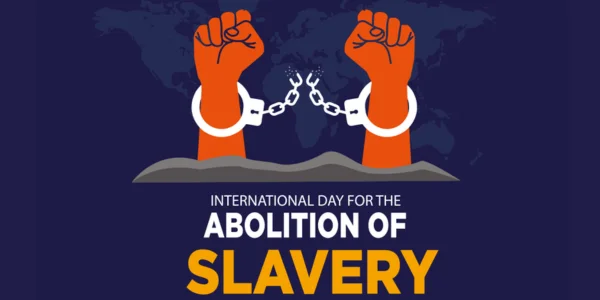The International Day for the Abolition of Slavery, observed annually on December 2, is a global initiative led by the United Nations to raise awareness about modern slavery and advocate for the eradication of practices that exploit human beings. This day emphasizes the need for collective action to address forced labor, human trafficking, child labor, and other forms of exploitation that continue to affect millions of people worldwide.
Here’s an in-depth look at the history, significance, and global efforts behind the International Day for the Abolition of Slavery.
History and Origins

The observance of this day dates back to 1949, when the United Nations General Assembly (UNGA) adopted the Convention for the Suppression of the Traffic in Persons and of the Exploitation of the Prostitution of Others. This landmark treaty aimed to combat human trafficking and the exploitation of vulnerable populations.
In 1985, the UN proclaimed December 2 as the International Day for the Abolition of Slavery to commemorate the adoption of the United Nations Slavery Convention in 1926. This convention marked a significant milestone in international efforts to combat slavery and its related practices.
What Is Modern Slavery?
Modern slavery encompasses a range of exploitative practices where individuals are subjected to control, coercion, and abuse. Unlike historical slavery, which was legally sanctioned, modern slavery is illegal but remains widespread. Forms of modern slavery include:
- Forced Labor: Coercing individuals to work against their will under threats of violence or punishment.
- Human Trafficking: Exploiting people through deception, coercion, or abduction for purposes such as forced labor, sexual exploitation, or organ trafficking.
- Child Labor: Exploiting children for work that is mentally, physically, socially, or morally harmful.
- Debt Bondage: Forcing individuals to work to repay a debt they can never clear.
- Forced Marriage: Marrying individuals against their will, often involving exploitation or abuse.
Statistics on Modern Slavery
The International Labour Organization (ILO) estimates:
- Over 50 million people were living in modern slavery in 2021, including 28 million in forced labor and 22 million in forced marriages.
- Women and girls are disproportionately affected, accounting for 71% of victims of modern slavery.
- Children make up one in four victims of modern slavery globally.
Significance of the Day
The International Day for the Abolition of Slavery highlights the urgency of addressing modern slavery as a severe violation of human rights. Its significance lies in:
- Raising Awareness: Educating people about the prevalence and impact of modern slavery and the need to end it.
- Advocating for Victims: Amplifying the voices of survivors and promoting their rights to justice and rehabilitation.
- Driving Policy Change: Encouraging governments to strengthen laws, enforcement mechanisms, and victim protection systems.
- Mobilizing Global Action: Inspiring collaboration among governments, organizations, and individuals to combat slavery.
Global Efforts to Eradicate Modern Slavery
The fight against modern slavery involves a multi-pronged approach led by international organizations, governments, and civil society. Key initiatives include:
1. International Labour Organization (ILO)
The ILO has been instrumental in combating forced labor through conventions such as:
- Forced Labour Convention (No. 29): Aims to eliminate forced labor in all its forms.
- Abolition of Forced Labour Convention (No. 105): Prohibits forced labor as a means of coercion or punishment.
2. Sustainable Development Goals (SDGs)
The 2030 Agenda for Sustainable Development prioritizes the eradication of modern slavery under Goal 8.7, which seeks to “end forced labor, modern slavery, and human trafficking.”
3. UNODC’s Global Action
The United Nations Office on Drugs and Crime (UNODC) plays a key role in addressing human trafficking and supporting the implementation of the UN Convention against Transnational Organized Crime and its Protocol to Prevent, Suppress, and Punish Trafficking in Persons.
4. Alliance 8.7
This global partnership works to accelerate efforts to eradicate forced labor, child labor, and human trafficking, bringing together governments, international organizations, and civil society.
Challenges in Combating Modern Slavery
Despite significant progress, the fight against modern slavery faces numerous challenges:
- Lack of Awareness: Many people are unaware of the signs of modern slavery or how to report it.
- Weak Law Enforcement: Inadequate resources and corruption hinder the enforcement of anti-slavery laws.
- Economic Inequality: Poverty and unemployment make vulnerable populations more susceptible to exploitation.
- Globalization: Complex supply chains can obscure instances of forced labor in industries such as agriculture, construction, and fashion.
How the Day is Observed
The International Day for the Abolition of Slavery is marked by activities and initiatives aimed at promoting awareness and action:
- Educational Campaigns: Workshops, lectures, and public discussions highlight the issue and promote preventative measures.
- Advocacy Events: NGOs and advocacy groups organize events to call for stronger laws and support systems for victims.
- Media Outreach: Documentaries, articles, and social media campaigns amplify the stories of survivors and educate the public.
- Policy Dialogues: Governments and international organizations host conferences to discuss strategies for eliminating slavery.
How You Can Contribute
As an individual, you can support the fight against modern slavery in various ways:
- Educate Yourself: Learn about modern slavery and share information with your community.
- Support Ethical Brands: Purchase products from companies with transparent and ethical supply chains.
- Report Suspicious Activity: Be vigilant about signs of trafficking or forced labor and report them to authorities.
- Advocate for Change: Support policies and initiatives aimed at eradicating slavery.
Looking Ahead: A Slavery-Free Future
The International Day for the Abolition of Slavery reminds us that while progress has been made, much work remains to eliminate modern slavery. Governments, organizations, and individuals must continue to collaborate, strengthen legal frameworks, and address the root causes of exploitation, such as poverty and inequality.
The global commitment to achieving SDG 8.7 and ensuring that no one is left behind underscores the possibility of a future free from slavery. By taking action today, we can create a world where every individual lives with dignity, freedom, and equality.
Conclusion
The International Day for the Abolition of Slavery is a powerful reminder of the resilience of the human spirit and the ongoing fight for justice and equality. As we honor this day, let us recommit ourselves to ending all forms of modern slavery, supporting survivors, and building a world where exploitation has no place. Together, we can turn the vision of a slavery-free world into reality.

